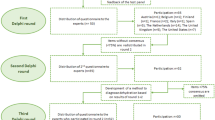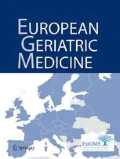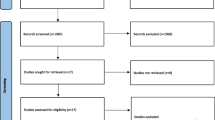Abstract
Context
Dehydration is a common yet underdiagnosed condition, which is associated with poor prognosis in older patients. The clinical and laboratory criteria for assessing dehydration are of variable or poor diagnostic value in this population and require further validation.
Objectives
To test different clinical and laboratory criteria for the early diagnosis of dehydration in hospitalized older patients as compared to the standard diagnosis based on a body weight gain ≥ 3% during the first week of admission.
Design
Prospective study using clinical and laboratory criteria for dehydration selected by an expert panel.
Setting
Acute geriatric unit.
Participants
Geriatric patients (n = 112; aged 83 ± 6 years) admitted to the unit.
Measurements
Using selected criteria (skin fold, dry mouth, calf muscle consistency, systolic blood pressure < 90 mmHg, orthostatic blood pressure drop, postural dizziness, thirst, apathy or delirium, urea, creatinine, uric acid, proteins, hemoglobin), expert clinicians prospectively assessed the patients to make a clinical diagnosis of dehydration upon admission. Clinicians were asked to provide a yes/no answer for each criterion and a global yes/no answer for dehydration, along with its estimated probability. Body weight was measured at admission and at Day 7. Laboratory parameters were assessed at baseline and at Day 7. The clinical diagnosis made at admission was retrospectively compared to the standard diagnosis made at Day 7 (> 3% weight gain) to test the values of each criterion separately, the global diagnosis, and its estimated probability.
Results
In total, 100 patients with complete data (mean age 83 ± 6 years) were considered for analysis. Dehydration was the principal reason for admission in three patients only but was clinically diagnosed as part of the study in 39 patients, whereas the standard diagnosis of dehydration was ascertained in 20. Inter-rater agreement (kappa) was fair for the clinical criteria and clinical diagnosis, moderate to near perfect for the laboratory criteria, and substantial for the estimated probability of dehydration. When matched with the standard diagnosis, the final clinical diagnosis of dehydration had 70% sensitivity and 69% specificity, with a 90% negative predictive value. Individually, both clinical and laboratory criteria had good specificity (65–90%), but poor sensitivity (< 55%).
Conclusions
Compared with the standard diagnosis, dehydration was overdiagnosed by systematic clinical assessment upon admission in this frail population. However, clinicians performed better at excluding dehydration. Clinical acumen seems better than any individual clinical symptom or sign.
Similar content being viewed by others

References
Thomas DR et al (2008) Understanding clinical dehydration and its treatment. J Am Med Dir Assoc 9(5):292–301
Rosler A et al (2010) Nutritional and hydration status in elderly subjects: clinical rating versus bioimpedance analysis. Arch Gerontol Geriatr 50(3):e81–e85
Phillips PA et al (1984) Reduced thirst after water deprivation in healthy elderly men. N Engl J Med 311(12):753–759
Hodak SP, Verbalis JG. Abnormalities of water homeostasis in aging. Endocrinol Metab Clin North Am 2005;34(4):1031–46, xi
Tian Y, Serino R, Verbalis JG (2004) Downregulation of renal vasopressin V2 receptor and aquaporin-2 expression parallels age-associated defects in urine concentration. Am J Physiol Renal Physiol 287(4):F797–F805
Vivanti A et al (2008) Clinical assessment of dehydration in older people admitted to hospital: what are the strongest indicators ? Arch Gerontol Geriatr 47(3):340–355
Warren JL et al (1994) The burden and outcomes associated with dehydration among US elderly, 1991. Am J Public Health 84(8):1265–1269
El-Sharkawy AM et al (2017) Dehydration and clinical outcome in hospitalised older adults: a cohort study. Eur Geriatr Med 8:22–29
Ferrucci L et al (1997) Hospital diagnoses, medicare charges, and nursing home admissions in the year when older persons become severely disabled. JAMA 277(9):728–734
Gross CR et al (1992) Clinical indicators of dehydration severity in elderly patients. J Emerg Med 10(3):267–274
Vivanti A, Harvey K, Ash S (2010) Developing a quick and practical screen to improve the identification of poor hydration in geriatric and rehabilitative care. Arch Gerontol Geriatr 50(2):156–164
Kovacs EM, Senden JM, Brouns F (1999) Urine color, osmolality and specific electrical conductance are not accurate measures of hydration status during postexercise rehydration. J Sports Med Phys Fitness 39(1):47–53
Eaton D et al (1994) Axillary sweating in clinical assessment of dehydration in ill elderly patients. Br Med J 308(6939):1271
Hargens AR et al (1983) Fluid shifts and muscle function in humans during acute simulated weightlessness. J Appl Physiol Respir Environ Exerc Physiol 54(4):1003–1009
Hargens AR (1983) Fluid shifts in vascular and extravascular spaces during and after simulated weightlessness. Med Sci Sports Exerc 15(5):421–427
Sinert R, Spektor M (2005) Evidence-based emergency medicine/rational clinical examination abstract. Clinical assessment of hypovolemia. Ann Emerg Med 45(3):327–329
Stookey JD, Pieper CF, Cohen HJ (2005) Is the prevalence of dehydration among community-dwelling older adults really low ? Informing current debate over the fluid recommendation for adults aged 70 + years. Public Health Nutr 8(8):1275–1285
Yoshihara A et al (2007) Serum markers of chronic dehydration are associated with saliva spinability. J Oral Rehabil 34(10):733–738
Huang LL et al (2010) Effects of profuse sweating induced by exercise on urinary uric acid excretion in a hot environment. Chin J Physiol 53(4):254–261
Al-Tawheed AR et al (2003) Anuria secondary to hot weather-induced hyperuricaemia: diagnosis and management. Ann Saudi Med 23(5):283–287
Tannheimer M et al (2010) Changes of hematocrit and hemoglobin concentration in the cold Himalayan environment in dependence on total body fluid. Sleep Breath 14(3):193–199
Rikkert MG, Melis RJ, Claassen JA (2009) Heat waves and dehydration in the elderly. Br Med J 339:b2663
Mc Gee S et al (1999) The rational clinical examination. Is this patient hypovolemic. JAMA 281(11):1022–1029
Weinberg AD, Minaker KL (1995) Dehydration, evaluation and management in older adults. Council on scientific affairs, american medical association. JAMA 274(19):1552–1556
Shirreffs SM (2003) Markers of hydration status. Eur J Clin Nutr 57(Suppl 2):S6–S9
Hooper L et al (2014) Water-loss dehydration and aging. Mech Ageing Dev 136–137:50–58
Hooper L et al. Clinical and physical signs for identification of impending and current water-loss dehydration in older people (protocol). The Cochrane Library 2012, Issue 2
Engel B et al (2004) Longitudinal measurements of total body water and body composition in healthy volunteers by online breath deuterium measurement and other near-subject methods. Int J Body Compos Res. 2(3):99–106
Kenkmann A et al (2010) Health, wellbeing and nutritional status of older people living in UK care homes: an exploratory evaluation of changes in food and drink provision. BMC Geriatr 10:28
Shimizu M et al (2012) Physical signs of dehydration in the elderly. Intern Med 51(10):1207–1210
Kinoshita K et al (2013) The measurement of axillary moisture for the assessment of dehydration among older patients: a pilot study. Exp Gerontol 48(2):255–258
Thomas DR et al (2003) Physician misdiagnosis of dehydration in older adults. J Am Med Dir Assoc 4(5):251–254
Mario S et al (2014) Accuracy of prediction equations for serum osmolarity in frail older people with and without diabetes. Am J Clin Nutr 100:867–876
Cheuvront SN et al (2010) Biological variation and diagnostic accuracy of dehydration assessment markers. Am J Clin Nutr 92(3):565–573
Rodrigues S et al (2015) Validation analysis of a geriatric dehydration screening tool in community-dwelling and institutionalized elderly people. Int J Environ Res Publ Health 12(3):2700–2717
Matthew B et al (2015) Is this elderly patient dehydrated? Diagnostic accuracy of hydration assessment using physical signs, urine, and saliva markers. J Am Med Dir Assoc 16:221–228
Hooper L et al (2016) Water-loss (intracellular) dehydration assessed using urinary tests: how well do they work? Diagnostic accuracy in older people. Am J Clin Nutr 104:121–131
Armstrong L et al (2007) Assessing hydration status: the elusive gold standard. J Am Coll Nutr 26(5 Suppl):575S–584S
Spinewine A et al (2007) Impact of a collaborative approach on the quality of prescribing for geriatric inpatients. J Am Geriatr Soc 55:658–665
Author information
Authors and Affiliations
Corresponding author
Ethics declarations
Conflict of interest
This study was financially supported by “Fondation Spadel”. The first author and the two last authors participated to a symposium organized by “Fondation Spadel” in November 2012, without being paid for it nor receiving any other advantages.
Ethical approval
The study was conducted in accordance with the Belgian legislation on human experimentation and was approved by the ethics committee of the CHU UCL Namur (IRB: 00010947).
Informed consent
Informed consent was obtained from all individual participants included in the study or from their legal representatives in case of cognitive function impairment.
Electronic supplementary material
Below is the link to the electronic supplementary material.
Rights and permissions
About this article
Cite this article
Betomvuko, P., de Saint-Hubert, M., Schoevaerdts, D. et al. Early diagnosis of dehydration in hospitalized geriatric patients using clinical and laboratory criteria. Eur Geriatr Med 9, 589–595 (2018). https://doi.org/10.1007/s41999-018-0100-0
Received:
Accepted:
Published:
Issue Date:
DOI: https://doi.org/10.1007/s41999-018-0100-0



